Tripatini
the world's smartest travel social network
Responsible Travel in Sierra Leone - Peninsula, Provinces and Palm Wine (Part 2)
Following on from the first installment of his adventure, Thomas recounts his experiences on his journey through Sierra Leone to discover tourism projects which work towards implementing the responsible tourism concept of "making destinations better places to live in, and better places to visit"
Part 2: The provinces - Waterloo to Bo & Beyond
My next mission was to visit another community tourism project based around an Island of outstanding natural beauty and rich in biodiversity found on the Moa River, and on the fringes of the Gola Forest in the South-East of Sierra Leone. Tiwai Island is owned by 8 communities who live around it, and, in theory, they all benefit equally from tourism. I am planning on basing my MSc Responsible Tourism Management dissertation on how this can be done successfully.
To reach Tiwai, I was to take a 'Poda Poda' (local mini-bus) from Waterloo to Bo, then travel from Bo to Potoru from where I was told to catch an 'Okada' (motorbike taxi) to Kambama where you can take a speedboat to reach the Island.

One of the villages dotting the side of the highway
The journey from Waterloo to Bo went without any incidents. We stopped a few times to pick people up or drop them off and this gave me the opportunity to learn a bit more about the differences between the coast and the hinterland. At every stop, tradesmen/women would come to the vehicles windows selling plantain crisps, 'Benny Cake' (sesame seed and sugar), grilled meat, bananas, oranges, corn, water, etc... you could never go hungry. The road was perfect. No pot-holes anywhere. I later learnt that an Italian prospecting company had invested in tarmacking the road which has now made a big difference between a day-long journey and a 3-4 hour journey.

The image which says: "West Africa" to me.
Arriving at Bo, I noticed a lot of social campaigns which were going on. Billboards denouncing domestic violence, encouraging family planning, addressing the AIDS/HIV issue, promoting agriculture and community, and many more. It was also my first reminder that there had been a civil war not so long ago. Billboards promoting the 'Guns for Development' campaign where an NGO was buying guns off people (very successful), 'Social Integration' and 'Peace Development' were common words around the city, even Diamond re-sellers were called 'Peace & Love'. Bo and the Provinces were the hardest hit by the civil war and where the worst atrocities were committed.
From Bo to Potoru - a ‘junction town’ leading to several villages, one of which was my destination - the road was less favorable. The rainy season was just ending, so heavy rain showers were common place. Pot-holes and mega-puddles dotted the road, and our driver - who's name is William 'Bobo' Decker - expertly guided the 'Poda Poda' without even breaking a sweat. Orange vendors and Plantain Crisp sellers were everywhere. The smell of 'the bush' is something you never forget. The sweet scent of tropical flowers mixed with the damp earth smell, the odour of oranges and limes; this coupled with the landscape of lush green vegetation, small streams meandering across the dirt road, the bridges crossing over fast flowing mighty rivers; time seems to go slowly yet you don't see it fly by.
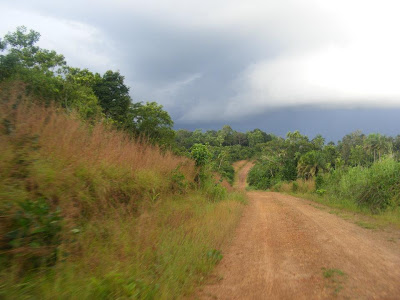
Road to Potoru. Notice the storm in the distance.
Potoru, which I later learnt was a rebel stronghold during the 1992 to 2002 war, was a quiet village which had a certain vibe about it. People were very friendly, respectful and eager to please. It was noticeably a trading hub too, being at the junction linking several villages together. We briefly stopped before we headed direction Kambama. Bobo Decker kindly offered to take me all the way as he had noticed that a tropical storm was brewing in the distance and knew that I would've gotten soaked if I had taken an 'Okada' (motorbike taxi).
The road was still dirt but was much better than the Bo to Potoru route. This was partly due to the small amount of vehicles that rode this way. We could see the storm approaching. Like a grey blanket, it covered the landscape, engulfed the forest, roads and villages. I thanked Bobo, as you can imagine. Finally, we arrived at Kambama. It was dusk and the distance rumble of thunder reminded us that we didn't have much time before another storm would unleash its wrath. I was guided down a path, from the village to the river bank and got on a speedboat captained by Ibrahim who told us a story about how crocodiles in the river and villagers had a mutual respect for each other.

Tiwai Island
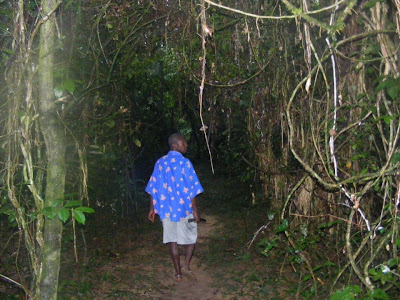
Local guide from Kambama leading me into the jungle
When we set foot on the island, I felt like an explorer. This was the real jungle! Creepers were hanging from the forest canopy, the sound of insects was overwhelming, birds were nesting above us. We started walking towards the camp where I would stay the night, and suddenly I heard something moving in the branches above me. I looked up and saw a black and white blur. A double take revealed that it was a monkey, a Diana monkey to be more precise. Ibrahim said: "This is a good start, you have already been very lucky!" and he was right.
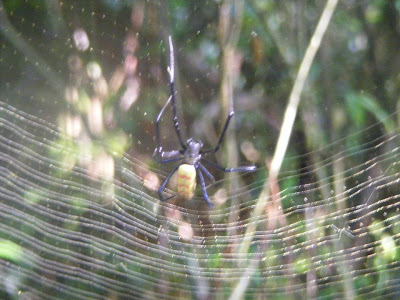
Can anyone identify this spider?
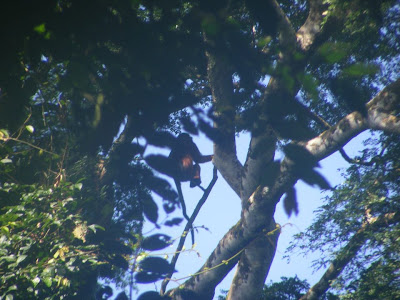
Red Colobus Monkey
The next morning, after a beautiful night's sleep, I went with a local guide on a 3 hour jungle trek where I saw a group of Red Colobus Monkeys, Black & White Colobus', Diana Monkeys, Suti Mangabe's, Hornbills, 'big-as-your-hand' spiders building their webs which shone golden-greenish hues when reflecting the sun’s rays, and the cream of the crop: 2 duikers; a very rare sighting according to my guide. Unfortunately, but not surprisingly, we did not come across the elusive pygmy hippo. Maybe next time.
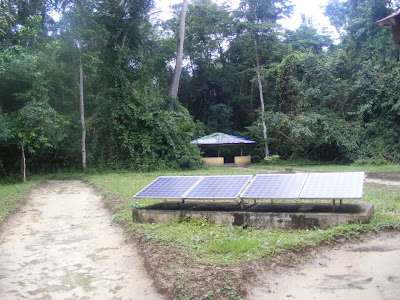
Solar power at Tiwai. Tent hut in the distance.

Traditional building where the food was prepared
During my stay, I also took a canoe onto the Moa River and learnt about traditional fishing techniques, wildlife, plants and pygmy hippo habits, as well as how to call monkeys by pinching your nose, mouth and emitting a cry so that they come to you thinking that you are a baby monkey in distress. The local language is Mende (from the Mende tribe) of which I learnt how to say:
'Hi Man/Old Man/Young Woman/Children' = 'Dake/Keke/Niande/Dupui Boaa'
'How are you?' = 'Ka hui ye na?'
'I am fine' = ' Ka ing goma'
The next morning, I took the speedboat at 4am in the morning to catch the local transport back from mainland. I will never forget speeding up the River Moa lit only by moonlight. That was definitely an experience.
In the next installment, Part 3: Back to the Peninsula - Coconut & Poyo Paradise, Thomas visits the communities located on the Western Peninsula to discover the tourism projects already put in place and the potential for implementing the responsible tourism concept.
To learn more about Responsible Tourism in West Africa, you can either visit the West Africa Discovery web portal, or join the growing community of West Africa passionate people here.
Videos
Groups
-
India
173 members
-
Tour Operators
873 members
-
Ireland
93 members
-
South Dakota
17 members
-
Azerbaijan
17 members
-
Shopping the World
55 members
-
Tech for Travel/Hospital…
87 members
-
Andorra
26 members
-
Online Corner
75 members
-
Minnesota
22 members
-
Backpackers & Hostels
84 members
-
Portugal
60 members
-
Turks and Caicos
26 members
-
Agritourism/Farmstays
72 members
-
Zambia
21 members
© 2025 Created by EnLinea Media.
Powered by
![]()
Badges | Report an Issue | Privacy Policy | Terms of Service
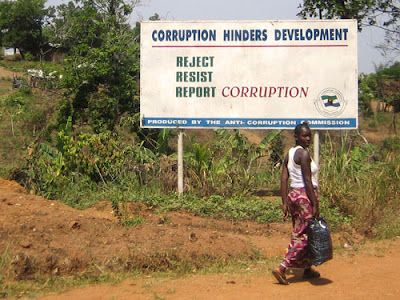
You need to be a member of Tripatini to add comments!
Join Tripatini